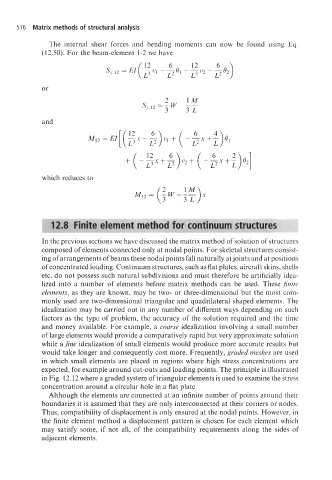Page 535 - Aircraft Stuctures for Engineering Student
P. 535
516 Matrix methods of structural analysis
The internal shear forces and bending moments can now be found using Eq.
(12.50). For the beam-element 1-2 we have
or
2 1M
sr,,2 - w - --
=
3 3L
and
(
M12=EI[(~~-$)~l+ -$x+t)QI
which reduces to
_.
12.8 Finite element method for continuum structures
In the previous sections we have discussed the matrix method of solution of structures
composed of elements connected only at nodal points. For skeletal structures consist-
ing of arrangements of beams these nodal points fall naturally at joints and at positions
of concentrated loading. Continuum structures, such as flat plates, aircraft skins, shells
etc, do not possess such natural subdivisions and must therefore be artificially idea-
lized into a number of elements before matrix methods can be used. These finite
elements, as they are known, may be two- or three-dimensional but the most com-
monly used are two-dimensional triangular and quadrilateral shaped elements. The
idealization may be carried out in any number of different ways depending on such
factors as the type of problem, the accuracy of the solution required and the time
and money available. For example, a coarse idealization involving a small number
of large elements would provide a comparatively rapid but very approximate solution
while a jine idealization of small elements would produce more accurate results but
would take longer and consequently cost more. Frequently, graded meshes are used
in which small elements are placed in regions where high stress concentrations are
expected, for example around cut-outs and loading points. The principle is illustrated
in Fig. 12.12 where a graded system of triangular elements is used to examine the stress
concentration around a circular hole in a flat plate.
Although the elements are connected at an infinite number of points around their
boundaries it is assumed that they are only interconnected at their corners or nodes.
Thus, compatibility of displacement is only ensured at the nodal points. However, in
the finite element method a displacement pattern is chosen for each element which
may satisfy some, if not all, of the compatibility requirements along the sides of
adjacent elements.

